Regional Employment Patterns in Scotland: Statistics from the Annual Population Survey, 2015
Summary publication of results from the Annual Population Survey 2015, presenting analysis on the labour market, education and training. Results are provided for Scotland and local authority areas in Scotland.
People not in Work
1,809,100 people over 16 in Scotland in 2015 were not in work, an increase of 130,100 since 2008.
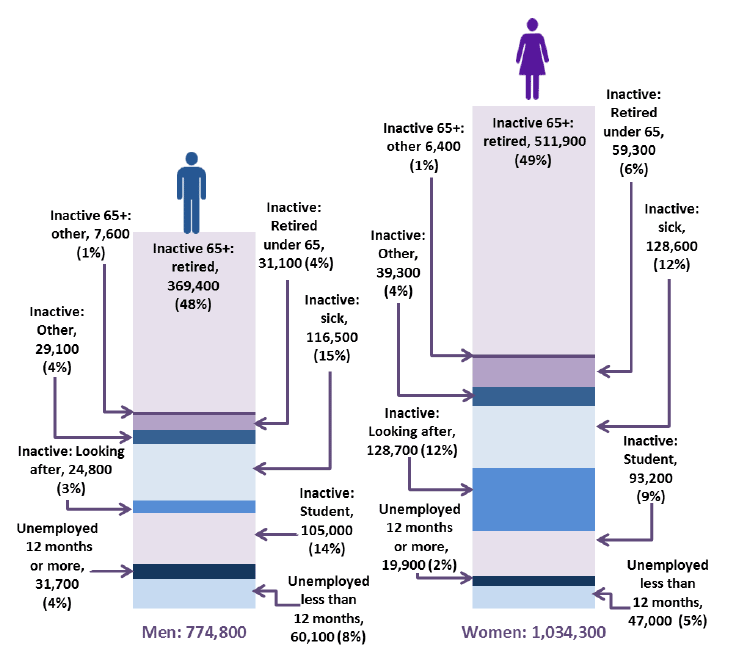
There were over 1.8 million people aged 16 and over in Scotland in 2015 who were not in work. However, the reasons for not being in work are varied, with different groups closer to being engaged in the labour market than others.
The unemployed are the closest to the labour market (as they are actively seeking employment and available to start work), however, they only constitute 8.8% of all who were not in work.
The economically inactive group accounts for remaining 91.2% of those not in work, but is itself, a diverse group. Many of this group choose not to work ( e.g. those who are retired) or are currently not able to work (due to ill-health or due to caring responsibilities). Others are engaged in education (which may improve their future employment prospects).
Unemployment rate decreased by 0.4 percentage points to 5.8% over the year, but is still 0.9 percentage points higher than in 2008.
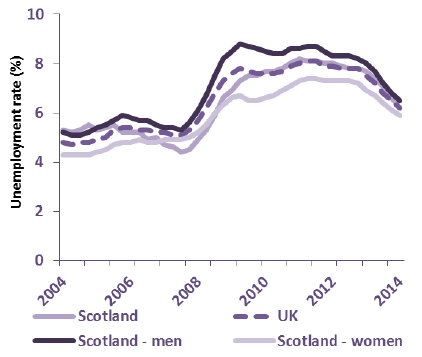
The unemployment rate in Scotland in 2015 was 5.8%, higher than the UK rate of 5.3%.
Over the year the rate has decreased in both Scotland and the UK (down 0.4 and 1.0 percentage points respectively).
Scotland's unemployment rate has increased by 0.9 percentage points since 2008 while it decreased by 0.4 percentage points in the UK.
There were 158,800 people aged 16 or over who were unemployed in Scotland, a decrease of 10,700 over the year.
The youth unemployment rate in Scotland decreased by 2.7 percentage points over the year to 14.3% in 2015.
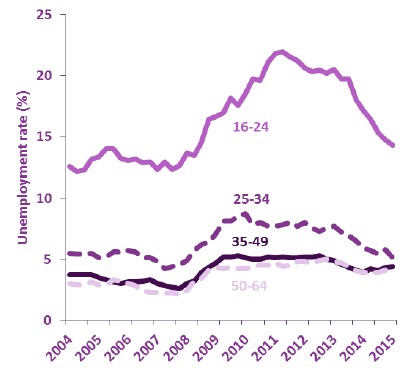
The youth (16-24) unemployment rate in Scotland is the highest of all age groups at 14.3%, (marginally lower than the UK rate of 14.4%).
The youth unemployment rate in Scotland decreased by 2.7 percentage points over the year, but has increased by 0.8 percentage points since 2008, while the UK rate has decreased by 2.8 percentage points since 2008 and 0.7 percentage points over the year.
Unemployment rates have been generally decreasing for all age groups between 2012 and 2015 as the economy started to recover from the effects of the recession.
Unemployment rates decreased in the majority of Scotland's local authorities over the year to 2015.
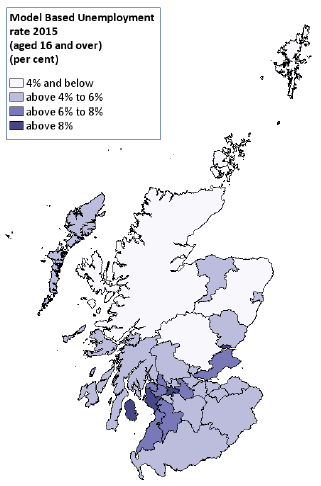
Model Based Unemployment [9] ( MBU) rates decreased in 26 of Scotland's 32 local authorities over the year.
In 2015, the highest MBU rates were seen in North Ayrshire (9.3%), Dundee City (8.9%) and Glasgow City (8.7%) and the lowest rates were seen in Shetland Islands (2.2%), Orkney Islands (2.4%) and Aberdeenshire (2.7%).
Over the year MBU rates decreased in 26 of the 32 local authority areas while 5 saw an increase and one remained unchanged. The only statistically significant change was seen in Clackmannanshire (down 2.2 percentage points).
MBU has increased in 28 of the 32 local authority areas since 2008 and decreased in 4 local authority areas. Statistically significant changes were seen in Dundee City (up 2.5 % percentage points), East Lothian (up 1.5 percentage points) and Falkirk (up 1.4 percentage points.
The number of 16-19 year olds who were NEET in 2015 increased by 3,000 over the year to 23,000.
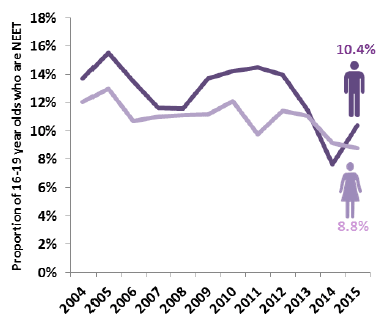
The proportion of 16-19 year olds who were NEET [10] in 2015 was 9.6%. This is an increase of 1.2 percentage points over the year, although this difference is not statistically significant.
Male NEET levels saw an increase of 2.7 percentage points rising to 10.4% over the year, while female NEET levels were down 0.4 percentage points to 8.8% over the year. Neither of these changes were statistically significant.
The increase in the number of 16-19 year NEETs in 2015 was driven by a rise in 18-19 year olds who were NEET.
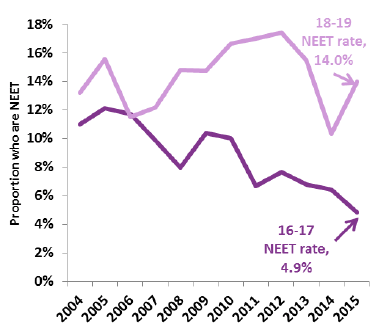
There is a clear difference between the trend for 16-17 year old and 18-19 year old NEET rates.
Over the year, there has been a significant increase of 5,000 in the level of 18,19 year olds who were NEET, whereas the number of 16-17 year old who were NEET is just slightly lower than in 2014.
The increase for 18-19 year olds is predominatly due to an increase in the estimated number who were unemployed.
The APS is not able to provide reliable data for those who are NEET at local area level. The Scottish Government in partnership with Skills Development Scotland have developed a new participation measure to address this. Information on this measure is available at:
Less than half (48.4%) of all unemployed people in Scotland have been unemployed for more than 6 months.
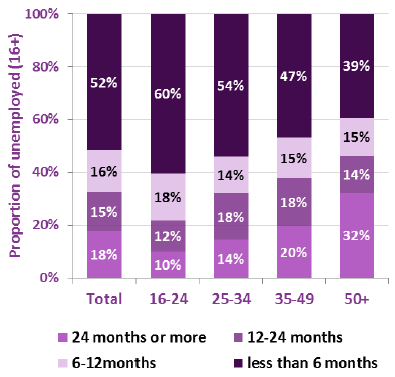
Of the 158,800 unemployed people in Scotland in 2015, over half (51.6%) were unemployed for less than six months.
The proportion that have been unemployed for less than 6 months has decreased by 16.7 percentage points since 2008, indicating a shift to lengthier durations of unemployment.
The shift to longer durations is in part due to changes to how claimants of Job Seekers Allowance/ Universal Credit are accounted for while they are on training schemes.
The 16-24 age group are least likely to be unemployed for more than 12 months (21.8%), while those aged 50+ are most likely to be unemployed for 12 months or more (46.2%).
Of the 760,900 economically inactive people (aged 16-64), over 50% were inactive because they were long term sick or were students.
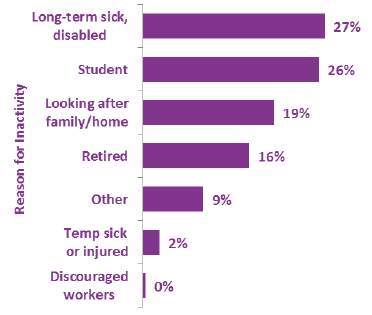
Economic inactivity covers individuals who are neither employed or unemployed. There are many reasons why people may be inactive: they may have a long-term illness or disability, be studying for a qualification, staying at home to look after their family, or have retired.
The economically inactive population are not part of the labour supply. However, the labour market is dynamic, with people continuously moving between different categories. Therefore it is important to consider inactivity figures as they include those who may make up the future labour supply and those who were part of the labour supply in the past.
Decrease in economic inactivity levels since 2008 driven by decreases in the number of long-term sick.
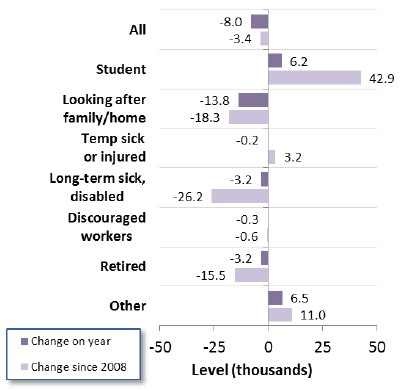
Economic inactvity levels in Scotland have decreased by 3,400 since 2008.
This has been driven mainly by a 26,200 decrease in those who are long-term sick, as well as an 18,300 decrease in those looking after family or home.
However, this decrease was somewhat offset by an increase of 42,900 in the number of students.
The decreases in inactivity levels for long-term sick and looking after family/home may be related to UK benefit reforms which are intended to move people in these groups closer to the labour market.
Scotland's lower inactivity rate compared to the UK is driven by lower rates for women.
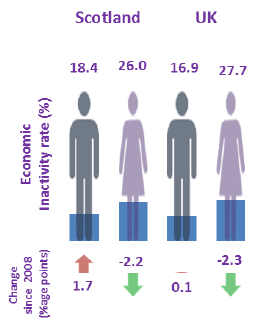
Since 2008, the economically inactivity rate for people aged 16-64 in the UK has decreased by 1.1 percentage points to 22.3%, compared to the 0.3 percentage points decrease to 22.3% in Scotland.
In both the UK and Scotland the change was driven by a decrease in the rate for women (2.2 percentage points to 26.0% for Scotland, 2.3 percentage points to 27.7% for the UK). Scotland saw an increase of 1.7 percentage points to 18.4% in the rate for males, whilst inactivity rate for males in the UK increased by 0.1 percentage points to 16.9%.
Economic inactivity rates decreased in 17 local authority areas over the year
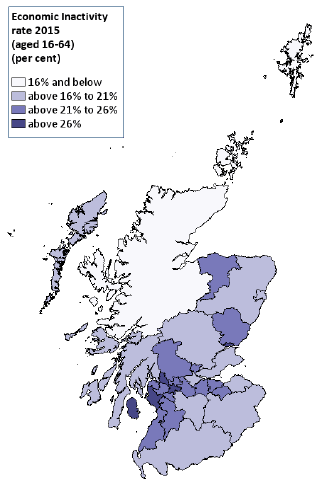
The local authority areas with the highest economic inactivity rates in 2015 in Scotland were Dundee City (30.3%), North Ayrshire (28.1%), and Glasgow City (27.3%).
The lowest inactivity rates in 2015 were seen in:
Orkney Islands (11.0%), Shetland Islands (12.7%), and Highland (15.9%).
Over the year, reductions were seen in 17 local authority areas, with 14 areas seeing increases and one seeing no change.
Since 2008, reductions in economic inactivity rates have been seen in 12 local authority areas, while 17 saw increases and three saw no change.
Just under a quarter (24.0%) of economically inactive people aged 16-64 in Scotland wanted to work, but were not currently able to do so.
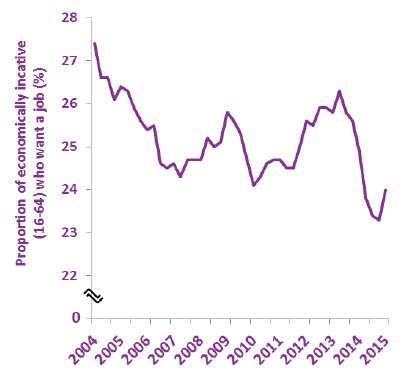
The proportion of those who were economically inactive, but who wanted to work has decreased over the past two calendar years by just under one percentage point per year, having previously been on an upward trend since 2010. However, the latest data shows a slight increase over data for Oct'14-Sep'15 data. It is too early to tell if this a developing trend.
The general reduction over the last two years may be related to the number of people who have moved out of inactivity into employment or unemployment over the year - many of those who did want work have found a job, therefore those who remain inactive predominatly are not seeking work.
Just over 129,000 people in Scotland in 2015 had never worked (excluding students aged 16-24 in full-time education).
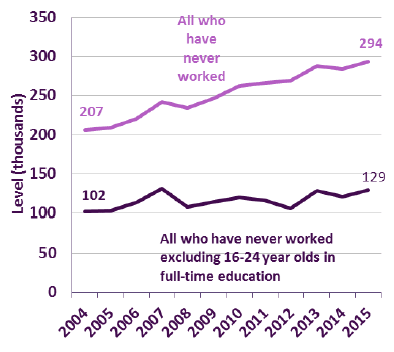
Just under 294,000 people in Scotland in 2015 have never worked, up 9,700 over the year.
Over half (56%) of these are 16-24 year olds in full-time education.
Excluding 16-24 year olds in full-time education, there were just over 129,000 people in Scotland who have never worked. This is an increase of 8,500 over the year.
15 local authorities saw a decrease in the number of people who have never worked over the year.
Contact
There is a problem
Thanks for your feedback